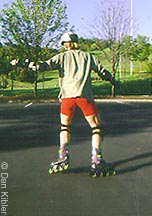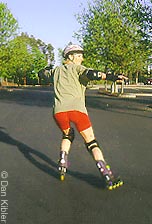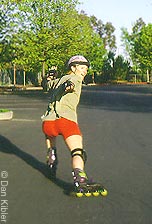Impressive. That's the first word that comes to mind whenever a skater pulls off a flawless powerslide. It's that instantaneous direction change, the wheel-shredding asphalt grind that cooks up this sure winner on the attention-o-meter. Add a little speed and attitude, and you've got it made. --www.skating.com
If you want to be considered a good skater, the powerslide is a requisite part of your portfolio. Although it's a bit extreme as a real-world stopping method, it does have its functional applications. It's great for pulling to a halt while aggressive skating or playing hockey, disciplines where heel brakes are rarely used. Of course, the move is even more popular for plain old hot-dogging.
In case you haven't seen a powerslide, it features a forward-rolling skater who then abruptly spins around 180° and uses the wheels to come to a backwards halt. The "slide" part happens in the backwards phase as the wheels of the braking skate get angled so far onto their sides -- the inside sidewalls, to be exact -- that they skid along the pavement. When done right, the move feels as good as it looks.
There are disadvantages to learning the forward powerslide, though. If your wheels catch on an uneven surface, the extreme lunge position puts you at risk of toppling over your skates or pulling a groin muscle. A long slide will wear flat spots on your wheels, and if the wheel bolts drag across the pavement, they risk damage, too. But what are these tradeoffs when you have the ability to look like a seasoned pro?
There are four possible front powerslide combinations, depending on which direction you like to spin and which leg you use for braking. These instructions describe a basic powerslide with the right skate extended and starting from a counterclockwise spin, the most natural (and popular) combination.
For your first time practicing this move, try to find some slick concrete, such as a painted basketball or volleyball court. A smooth surface makes it easier and safer to slip into a slide when you're first learning. Place a marker or draw a line on the pavement to use as a spotting aid for approaches and stops.
Building Blocks
Before attempting the forwards powerslide, you first need to learn a few primer moves: parallel turns, spin transitions and backwards powerslides. While you practice these, stay loose and low, and rehearse Carving a parallel turn. To practice ultratight turns, set up a slalom course. each skill several times before advancing to the final drill, where you'll bring it all together. Don't be frustrated if you're too tired to get it all in just one day. Breaking it up into a couple of days will keep your mind fresh and your back from griping about all the twisting and turning
Parallel Turns
To practice ultratight turns, set up a slalom course. These ski-like turns require you to swerve in either direction with your wheels tipped onto the corresponding edges, i.e. left edges for left turns.
- While rolling, scissor your legs, moving the right skate forward and aligning its back wheel with the front wheel of the left skate. They can also be further apart, but ideally not closer together. The skates should stand less than shoulder-width apart from each other.
- To turn right, shift your weight onto the left skate, while twisting the hips toward the right.
- Lean toward the center point of the turn with your weight distributed 75 percent on your left skate and 25 percent on the back wheels of your right skate. Keep all wheels on the pavement.
- Both skates will curve to the right as the wheels tilt onto their right edges.
TROUBLESHOOTING
- Commit to the tilt by twisting your hips and left knee to the right, toward the center of the turn
- If necessary, practice this to the left first; it's the direction most people favor. The left skate goes in front for left parallel turns, the right skate for right turns.
- Caught mid-transition, weight equally distributed on each side.
Spin Transitions
This move allows to you spin around 180° from forward to backward while remaining in motion. It's preferredly done by pivoting on one or both toe wheels.
- Coasting forward, look over your left shoulder and let your hips follow to start an A-frame (wide-stance) turn to the left.
- Transfer your weight to your right skate, unweighting the left skate so you can lift up your left heel and pivot at the toe. The heel of your left skate, as you set it down, should now be pointed toward the heel of the right skate.
- Equalize your balance on both feet and complete the spin, knees out and heels in.
TROUBLESHOOTING
- For easier rotations, raise both outstretched arms to the sides for balance (think propeller blades). Commit to the spin by swinging them left during the move.
- If you can't manage to a pivot on the left skate, drag its toe wheel during the right-skate weight shift. The contact point adds stability, and the drag helps pull your knees apart.
- The classic powerslide position, with eyes on the stopping mark.
Backward Powerslide
The best way to stop backwards is also the second half of the powerslide maneuver. This will get you a good feel for the slide of the wheels before you have to worry about turning around.
- Skating backward in a coasting roll, sink into a crouch and look over the right shoulder to view your stopping mark. Keep your gaze fixed there until you stop.
- Lunge over your left knee and push the right skate away from your body. Arc the right skate back and toward the direction of travel, gradually increasing the pressure on the inside wheel edges by transferring some weight from the left skate.
- As the right skate extends away from the body, it tips steeply onto its sidewalls and begins to slide while the left skate rolls backward.
- Once the right skate's wheels are perpendicular to the direction of travel, rise slightly from your lunge to better leverage the pressure on the pavement.
TROUBLESHOOTING
Go in low and come out high.
Putting It All Together
Once you've gotten all the necessary skills put together, it's time to wrap them up into one thrilling package. Here's the step-by-step process to accomplish the forward powerslide:
- Approach your stopping mark at a moderate speed. Twenty feet out, raise both arms to the sides, propeller-style.
- Scissor the right skate ahead, swing the left hand in front and right-hand in back as you make an abbreviated right parallel turn, with most of your weight on the left skate. This is the "wind-up" for the spin.
- With eyes fixed on your stopping mark, transfer most of your weight briefly to the right skate while steering it left. The moment the left skate is unweighted, pivot it 180° on the toe wheel. At the same time, assertively swing your outstretched arms counterclockwise 180° so the right hand is pointing toward your mark and the left is pointing away (but keep your eyes on that mark!).
- Sink into a deep crouch over your left knee and finish sweeping your right skate into the direction of travel.
- As your right inside sidewalls cross the line of travel, momentum and your lunge over the backward left skate allow you to slide across the pavement.
- When you're ready to quit showing off and actually stop, rise slightly from the lunge to better leverage the right skate's pressure on the pavement.



In sequence, pivot the left skate (left photo) so that it's rolling backward, lunge onto the left skate and sweep the right skate around (center), then finish in style (right).
TROUBLESHOOTING
- If the wheels on your braking skate skip across the pavement instead of sliding, start from a lower lunge over the left knee (or find smoother pavement).
- Swing your outstretched arms clockwise for better rotation and counterbalance during the spin portion of the move.
- Practice, practice practice!
The Rollerblade TRS Lightening skates I'm wearing in these photos are still comfortable and useful after 10 years. Like the original edition of Get Rolling, they're true classics! -- Liz